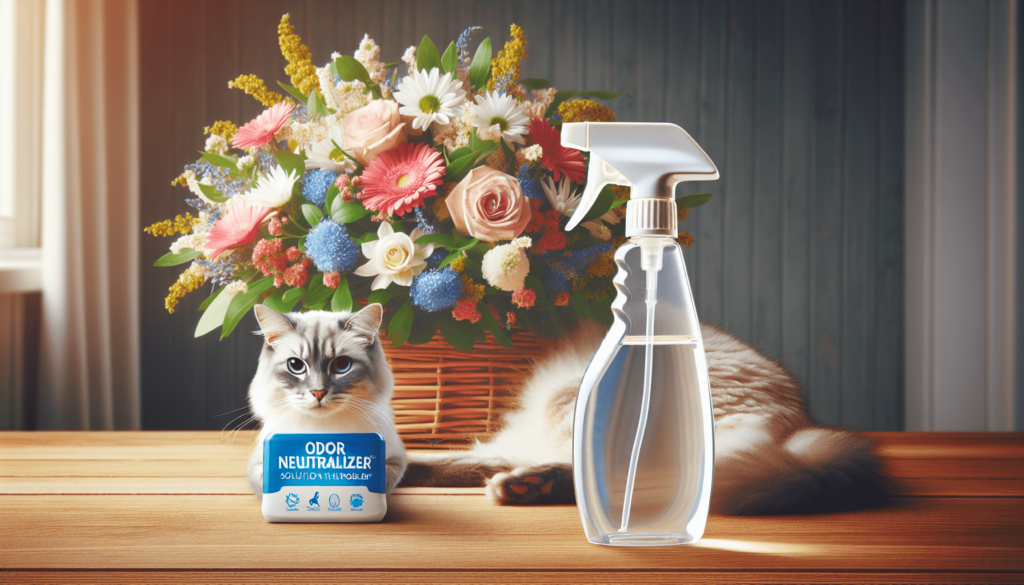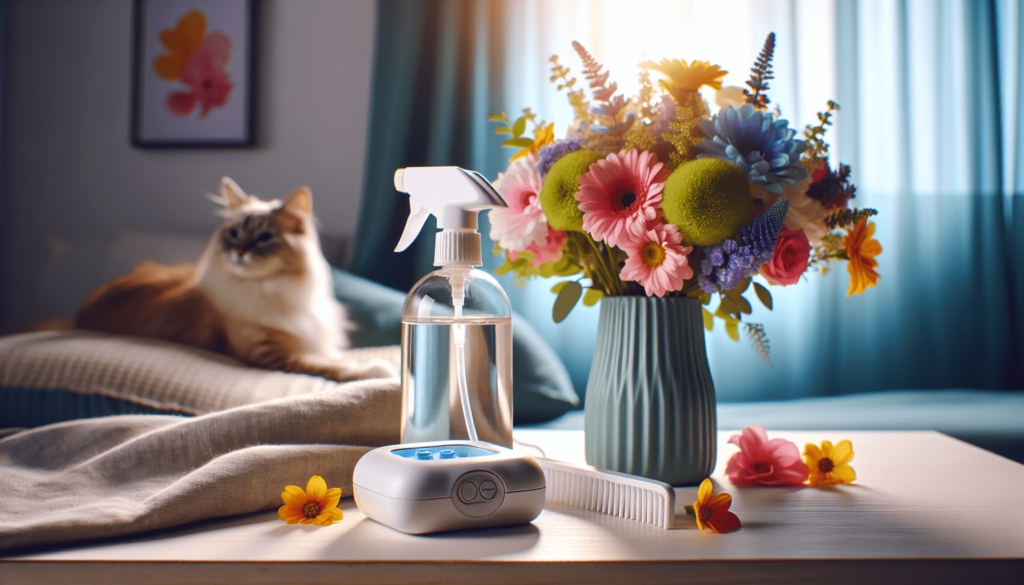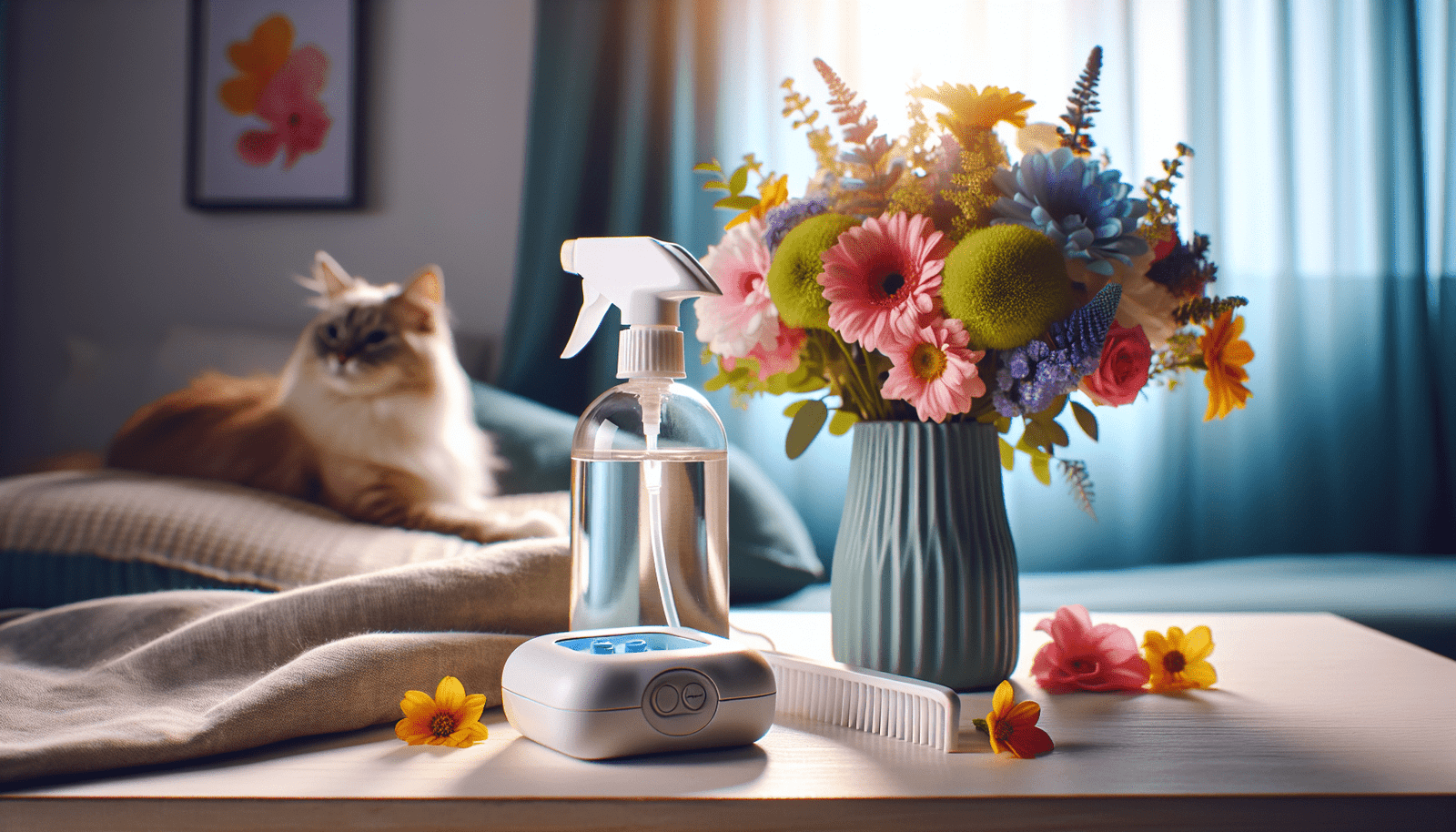We all know that living with a furry friend has its ups and downs. While cats can be adorable, their occasional accidents can leave behind a lingering and unpleasant odor. Whether you’re a new cat owner or a seasoned one, dealing with the notorious cat pee smell is a challenge we’ve all faced. In this article, you’ll discover some simple yet effective tips and tricks to eliminate that pesky odor and restore freshness to your home. Say goodbye to those embarrassing moments and hello to a home that smells clean and inviting once again.

Identifying Cat Urine Smells
Detecting the source of the smell
When you start noticing a strong, unpleasant smell in your home, it’s important to determine whether it is indeed cat urine. The first step in identifying cat urine smell is to locate the source of the odor. Cats tend to urinate in specific areas, so pay attention to any particular spots or corners in your home where the smell seems to be more concentrated. Use your sense of smell and follow the odor to identify the exact location.
Differentiating between cat urine and other smells
Sometimes, identifying the smell of cat urine can be challenging, especially if your cat has recently urinated in an inconspicuous area. To differentiate between cat urine and other smells, you can try using your sense of smell or use a blacklight. Cat urine has a distinct ammonia-like odor that is different from other smells in your home. Additionally, if you suspect that a particular area has been soiled, using a blacklight can help identify any hidden urine stains. Cat urine will glow under ultraviolet (UV) light, making it easier to spot.
Using ultraviolet light to identify cat urine stains
To effectively identify cat urine stains, you can utilize an ultraviolet (UV) light, commonly known as a blacklight. This special light causes compounds in cat urine to fluoresce, making them more visible to the human eye. Simply turn off the lights in the room, and carefully inspect the suspected area with the UV light. Any cat urine stains will appear as glowing spots or streaks. Using a blacklight can be particularly helpful in large or carpeted areas where the source of the smell might be harder to detect.
Preventing Cat Urine Smells
Training your cat to use the litter box
One of the key steps in preventing cat urine smells is to ensure that your furry friend is properly trained to use the litter box. Start by providing a clean and easily accessible litter box in a quiet and private location. Show your cat where the litter box is located and gently place them in it after meals or naps. Consistently praise and reward your cat when they use the litter box correctly. If your cat continues to have accidents outside the litter box, consult with a veterinarian to rule out any medical issues and consider professional assistance from a feline behaviorist.
Maintaining a clean litter box
Regularly cleaning the litter box is crucial in preventing cat urine smells. Cats are naturally clean animals, and a dirty litter box may discourage them from using it. Scoop the litter box daily to remove any waste and clumps and dispose of them properly. Once a week, empty the entire litter box and thoroughly clean it with mild soap and water. Avoid using strong-smelling cleaners, as cats may be deterred by the scent, leading to litter box avoidance.
Addressing any medical issues causing inappropriate urination
If your cat is consistently urinating outside the litter box, it’s essential to rule out any underlying medical conditions that may be causing this behavior. Inappropriate urination can be a sign of urinary tract infections, bladder stones, or other medical issues. Schedule a visit with your veterinarian to have your cat examined and tested for any potential medical concerns. Treating the underlying cause is crucial in preventing future accidents and eliminating cat urine smells.
Using cat-friendly cleaning solutions
When addressing cat urine smells, it’s important to use cleaning solutions that are safe for both your cat and your home. Avoid using harsh chemicals or cleaners with strong fragrances, as these can be toxic to cats and may contribute to the smell. Opt for cat-friendly cleaning solutions that are specifically formulated to neutralize cat urine odor. These products usually contain natural enzymes that break down the urine molecules, effectively eliminating the smell. Look for enzymatic cleaners that are labeled as safe for use around pets.
Immediate Response to Fresh Cat Urine
Blotting the area with paper towels
When you discover fresh cat urine, it’s important to address it promptly to prevent further odors from developing. Start by blotting the affected area with paper towels or absorbent cloths to remove as much liquid as possible. Avoid rubbing or scrubbing, as this may spread the urine and make it more difficult to clean. Place a generous amount of pressure on the paper towels to absorb the urine effectively.
Avoiding heat and harsh chemicals that may set the smell
Using heat or harsh chemicals on fresh cat urine can actually make the smell more difficult to remove. Avoid using hot water or any type of heat source to dry the area, as this can cause the urine to set into the fabric or surface. Also, refrain from using bleach or ammonia-based cleaners, as these chemicals can create a pungent odor when combined with cat urine. It’s important to treat fresh accidents using appropriate cleaning methods to prevent long-lasting smells.
Cleaning the area thoroughly with water
After blotting the area with paper towels, it’s time to clean the affected area thoroughly with water. Use a clean cloth or sponge dampened with cold water to gently dab the spot. Be cautious not to oversaturate the fabric or surface, as excess moisture can lead to mold or damage. Continue blotting until the water runs clear, indicating that most of the urine has been removed. This immediate cleaning process will help prevent the urine from seeping deeper into the material, reducing the chances of lingering smells.
Scientifically Proven Cleaning Solutions
Choosing enzymatic cleaners
Enzymatic cleaners are scientifically proven to be highly effective in eliminating cat urine smells. These cleaners contain enzymes that break down the urine at a molecular level, effectively neutralizing the odor. When choosing an enzymatic cleaner, look for one specifically formulated for cat urine. These products are designed to target the specific compounds found in cat urine and provide the best results. Ensure that the cleaner is fresh and hasn’t expired, as the effectiveness of the enzymes can diminish over time.
Understanding how enzymes break down cat urine odor
Enzymes are natural proteins that act as catalysts, accelerating chemical reactions. In the case of cat urine odor, the enzymes in cleaning solutions specifically target the uric acid crystals found in the urine. When the enzymes come into contact with the uric acid, they break it down into carbon dioxide and ammonia, effectively eliminating the odor-causing molecules. Enzymatic cleaners work by neutralizing the odor at its source, rather than masking it with fragrances.
Applying enzymatic cleaners correctly
To achieve optimal results with enzymatic cleaners, it’s important to follow the instructions provided by the manufacturer. Begin by removing any excess urine or moisture from the area. Apply the enzymatic cleaner generously, ensuring that it saturates the affected area completely. Allow the cleaner to sit for the recommended amount of time, as specified on the product label. During this time, the enzymes will continue to break down the urine molecules. After the designated period, blot the area with a clean cloth or paper towels to remove any excess moisture and residual odor.

Using Vinegar and Baking Soda Solution
Preparing a homemade solution
A homemade vinegar and baking soda solution can be an effective remedy for cat urine smells. To prepare the solution, mix equal parts of white vinegar and water in a spray bottle. Sprinkle a generous amount of baking soda over the affected area and then spray the vinegar solution on top. The vinegar will react with the baking soda, creating a foaming action that helps break down the urine odor. Allow the solution to sit for approximately 15 minutes to neutralize the odor.
Discussing the effectiveness of vinegar and baking soda
Vinegar and baking soda are known for their natural deodorizing properties and can be effective in eliminating cat urine smells. Vinegar acts as a disinfectant and helps neutralize the alkaline properties of cat urine. Baking soda, on the other hand, absorbs odors and works to neutralize the acidic components of the urine. Together, they can help combat the odor-causing molecules and leave the area smelling fresh. However, it’s important to note that this homemade solution may not be as potent as enzymatic cleaners, particularly for deeply ingrained stains or strong odors.
Applying the vinegar and baking soda solution
To apply the vinegar and baking soda solution, start by removing any excess urine with paper towels or a clean cloth. Sprinkle a generous amount of baking soda over the affected area, ensuring that it covers the entire stain. Then, using the spray bottle filled with the vinegar and water solution, mist the area thoroughly. Allow the solution to sit for approximately 15 minutes to allow the vinegar and baking soda to work their magic. Afterward, blot the area with a clean cloth or paper towels to remove any excess moisture and residual odor.
Using Peroxide-Based Solutions
Understanding the use of peroxide in removing cat urine smell
Peroxide-based solutions can be an effective option for removing cat urine smell, especially for lighter-colored fabrics or surfaces. The hydrogen peroxide in these solutions acts as a bleaching agent, helping to remove stains and eliminate odor-causing molecules. However, it’s essential to ensure that the surface or fabric you are treating is compatible with hydrogen peroxide, as it can cause discoloration or damage certain materials. Always perform a patch test in an inconspicuous area before using peroxide-based solutions on larger or more visible areas.
Creating a homemade peroxide and dish soap solution
To create a homemade peroxide and dish soap solution, mix 2 parts hydrogen peroxide with 1 part dish soap in a spray bottle. Gently swirl the mixture to combine the ingredients, being cautious not to create excessive suds. This solution can be effective in breaking down the urine odor molecules and reducing staining. However, avoid using dish soaps that contain bleach or ammonia, as these can react with the peroxide and create harmful fumes.
Applying peroxide-based solutions
Before applying the peroxide-based solution, it’s important to remove any excess urine by blotting the area with paper towels or a clean cloth. Spray the peroxide and dish soap solution onto the affected area, ensuring that it is thoroughly saturated. Allow the solution to sit for approximately 10 minutes, giving it time to break down the urine odor. Afterward, blot the area gently with a clean cloth or paper towels to remove any excess moisture. Always follow up with a thorough rinsing using clean water to remove any residue from the peroxide solution.
Deep Cleaning Carpets and Fabrics
Renting or purchasing a deep cleaner
For more extensive or deeply ingrained cat urine stains and smells, deep cleaning your carpets and fabrics may be necessary. Renting or purchasing a deep cleaner can help you thoroughly clean larger areas in your home. Deep cleaners use a combination of hot water and cleaning solutions, along with powerful suction, to extract dirt, stains, and odors from carpets and fabrics. Ensure that the deep cleaner you choose is suitable for the type of flooring or fabric you are cleaning.
Choosing the right cleaning solution for your machine
When using a deep cleaner, it’s important to choose the appropriate cleaning solution for your specific machine. Many deep cleaners have their own brand of cleaning solutions that are specifically formulated for optimal performance. These solutions often contain enzymes or other odor-neutralizing ingredients that can effectively tackle cat urine smells. Follow the manufacturer’s instructions to determine the correct amount of cleaning solution to use, and be sure to test the solution on a small, inconspicuous area before treating the entire carpet or fabric.
Best practices for deep cleaning to remove cat urine smell
Before deep cleaning, thoroughly vacuum the area to remove any loose debris or dirt. Fill the deep cleaner’s water tank with the recommended amount of water and cleaning solution. Start at one corner of the room and work your way systematically, following the manufacturer’s instructions for operating the deep cleaner. Pay extra attention to any areas that have been previously soiled with cat urine. Take your time and make multiple passes over these areas to ensure effective cleaning and odor removal. Allow the cleaned carpet or fabric to dry completely before allowing pets or foot traffic in the area.
Cleaning Hard Surfaces
Choosing the right cleaning products for different surfaces
When it comes to cleaning hard surfaces, such as tile, laminate, or hardwood floors, it’s essential to choose the appropriate cleaning products to effectively remove cat urine smells. Avoid using products that contain ammonia, as the scent can mimic that of cat urine and potentially attract your cat to the spot. Look for mild, cat-friendly cleaners that are specifically formulated for the type of surface you are cleaning. For hardwood floors, opt for cleaners that are suitable for use on wood to prevent damage or discoloration.
Applying cleaners to hard surfaces
To clean hard surfaces affected by cat urine, begin by removing any excess moisture or urine with paper towels or a clean cloth. Spray or apply the chosen cleaning solution onto the surface and allow it to sit for a few minutes. Gently scrub the area with a soft brush or sponge, paying attention to any grout lines or crevices. Rinse the area thoroughly with water to remove any residual cleaning solution. Dry the surface completely with a clean cloth or towel to prevent any slipping hazards.
Ensuring all cat urine residue is removed
To ensure all cat urine residue is removed from hard surfaces, it’s important to be thorough in your cleaning process. Take extra care when scrubbing grout lines or textured surfaces, as these areas can trap urine and odors. Use a soft brush or toothbrush to agitate the cleaning solution into these areas for better penetration. After rinsing the surface, check for any remaining odor or staining. If you detect any lingering smells, repeat the cleaning process or consider using a more potent enzymatic cleaner to completely eliminate the cat urine odor.
Dealing with Old Cat Urine Stains and Odors
Recognizing old cat urine stains
Old cat urine stains can be more challenging to detect, as they may not be as apparent or leave a strong odor. However, they can still contribute to persistent smells if not properly addressed. Look for areas that appear discolored or have a different texture than the surrounding surface. If you’re having difficulty locating the old stains, try using a blacklight to help identify any hidden spots. Old urine stains may require more intensive cleaning methods to completely remove the odor.
Finding the best methods to remove old stains
When tackling old cat urine stains, the goal is to break down and remove any residual urine crystals that are causing the odor. Enzymatic cleaners, due to their ability to target and neutralize these crystals, are often the most effective method for removing old stains. Follow the instructions provided with the enzymatic cleaner, ensuring that the affected area is thoroughly saturated. Allow the cleaner to sit for an extended period to give the enzymes enough time to break down the urine molecules. Afterward, repeat the cleaning process as needed until the odor is completely eliminated.
Repeating cleaning process until odor is completely eliminated
It’s important to be persistent when dealing with old cat urine stains and odors. Sometimes a single round of cleaning may not be enough to completely remove the odor. If the smell persists after the first cleaning, repeat the cleaning process, making sure to thoroughly saturate the affected area with the enzymatic cleaner. Allow the cleaner to sit for an extended period, and then blot or extract any excess moisture. Continue repeating the cleaning process until the smell is completely eliminated. Patience and persistence will ultimately lead to success in getting rid of old cat urine stains and odors.
Preventing Recurrences
Identifying reasons your cat may not be using the litter box
To prevent recurrences of cat urine smells, it’s crucial to identify the reasons why your cat may not be using the litter box. There are several potential factors that could contribute to this behavior, including litter box cleanliness, litter type, placement of the litter box, or stress. Evaluate these factors and make any necessary adjustments to create an environment that encourages litter box use. Observing your cat’s behavior and consulting with a veterinarian or feline behaviorist can also provide valuable insights into addressing any underlying issues.
Using cat deterrents to keep cats away from certain areas
If your cat has a tendency to urinate in specific areas of your home, using cat deterrents can be an effective preventive measure. There are various cat deterrent products available, including sprays, diffusers, or motion-activated devices that emit sounds or sprays of water. These deterrents can be used to discourage your cat from accessing or soiling certain areas. However, it’s important to introduce these deterrents gradually and in conjunction with positive reinforcement of appropriate litter box behavior.
Regularly cleaning areas that have been previously soiled
To prevent recurrences of cat urine smells, it’s vital to regularly clean any areas that have been previously soiled. Even if the odor has been eliminated, the scent may still be present to your cat, which could attract them to the spot again. Regularly clean these areas using appropriate cleaning methods and products. By maintaining cleanliness and removing any remaining scent, you can deter your cat from revisiting these areas and reinforce the importance of using the designated litter box.
By following these comprehensive tips and techniques, you can effectively identify and eliminate cat urine smells in your home. Remember to address the source of the smell, prevent recurrences through proper cat training and maintenance, respond immediately to fresh accidents, utilize scientifically proven cleaning solutions, and take the necessary steps to deep clean carpets, fabrics, and hard surfaces. With the right approach and persistence, you can create a clean and odor-free environment for both you and your feline friend.

